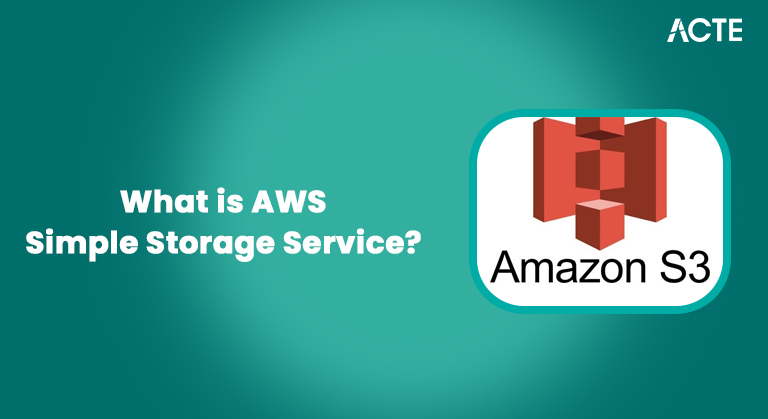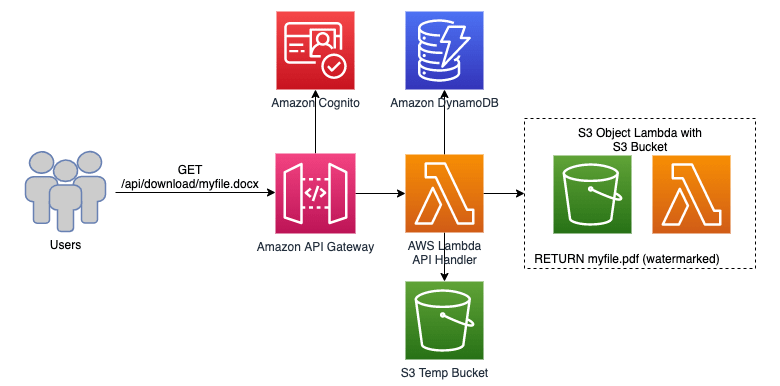
- Introduction to AWS S3
- Key Features of AWS S3
- How AWS S3 Works
- Benefits of AWS S3
- Use Cases of AWS S3
- AWS S3 Storage Classes
- Pricing of AWS S3
- Conclusion
Introduction to AWS S3
AWS Simple Storage Service (S3) is a scalable, durable, and low-latency object storage service provided by Amazon Web Services (AWS). Launched in 2006, S3 enables organizations to store and retrieve any amount of data at any time, making it a versatile solution for a wide range of use cases. From storing backups and archives to hosting website content and managing big data, S3 offers an ideal platform for businesses of all sizes. Data in S3 is stored as objects within “buckets,” with each object ranging from small files to petabytes of data, a concept thoroughly explained in Amazon Web Services Training. Its architecture is designed for high durability, offering 99.999999999% durability, and it supports fast, low-latency access to data. S3’s scalability ensures that businesses can easily accommodate growing storage needs without compromising performance. Additionally, its seamless integration with other AWS services, including computing, security, and analytics tools, makes it a powerful and efficient solution for cloud storage. With a user-friendly interface, high availability, and pay-as-you-go pricing, S3 has become one of the most popular and trusted cloud storage options globally.
To Earn Your AWS Certification, Gain Insights From Leading AWS Experts And Advance Your Career With ACTE’s AWS Course Today!
Key Features of AWS S3
AWS S3 provides a range of features that make it one of the most influential and flexible storage services available today:
- Scalability: AWS S3 allows you to store virtually unlimited amounts of data. The service automatically scales to meet your needs, so you don’t need to worry about running out of storage space as your data grows.
- Durability: Amazon S3 is known for its 99.999999999% durability (11 9’s). Data is automatically replicated across multiple Availability Zones (AZs) in an AWS region, ensuring high resilience against hardware failures.
- Low-Cost Storage: AWS S3 offers flexible storage classes, allowing you to optimize costs based on your usage patterns, a strategy that can be integrated with Automate CI/CD with Azure DevOps Pipelines for more efficient workflows. You can store frequently accessed data in one class and archive infrequently accessed data in a more cost-effective option.
- Data Management: AWS Simple Storage Service offers built-in lifecycle management tools to automate data archiving and deletion, making it easy to manage data retention policies.
- Global Access: Data in S3 is available globally and can be accessed from anywhere with an internet connection, making it ideal for applications with a worldwide reach.
- Security: S3 integrates with AWS IAM to manage user permissions. It also supports encryption for both data at rest and data in transit.
- Creating Buckets: You first create a bucket to store your data. Buckets are globally unique, meaning no two AWS users can create a bucket with the same name.
- Data Replication: S3 automatically duplicates your data across multiple availability zones in the region to ensure that your data is safe even in case of hardware failures.
- Uploading Data: Once your bucket is created, you can upload objects (files) to the bucket using the AWS Management Console, AWS CLI (Command Line Interface), or programmatically through AWS SDKs (Software Development Kits).
- Storing Objects: Each object consists of data (the file), metadata (information about the file, such as its size and content type), and a unique key to retrieve it, similar to how Azure Log Analytics for Monitoring and Diagnosing manages data for efficient tracking and retrieval.
- Accessing Data: Once stored, data in S3 can be accessed using the object key. You can set access controls, use pre-signed URLs for temporary access, or integrate S3 with other AWS services to manage data access.
- Versioning: S3 supports versioning, which means that every time you upload a new version of an object, S3 will store both the old and new versions of the object. This is useful for backup and data recovery.
- Backup and Restore: S3 is commonly used for backing up critical data and files, providing a secure, durable, and cost-effective solution for long-term storage.
- Data Archiving: Businesses use S3 to archive old, infrequently accessed data. With storage classes like S3 Glacier, you can store data at a lower cost while ensuring it is available when needed.
- Website Hosting: AWS S3 can host static websites (such as HTML, CSS, and JavaScript files), a feature often highlighted in AWS Training. It’s ideal for serving content like images, videos, or documents.
- Big Data Analytics: S3 is commonly used as a data lake for storing massive amounts of structured and unstructured data that can be processed and analyzed by services like Amazon Athena, AWS Glue, and Amazon Redshift.
- Media and Content Distribution: Content creators and media companies use S3 to store and deliver high-volume media content (videos, images, and audio) to users globally through integration with Amazon CloudFront for content delivery.
- Disaster Recovery: S3’s high durability and availability make it a great choice for disaster recovery solutions. It allows businesses to store critical data that can be restored if primary data systems fail.
- S3 Standard: This standard is designed for frequently accessed data. It provides low-latency and high-throughput performance, which is ideal for applications such as content distribution or big data analytics.
- S3 Intelligent-Tiering: This storage class automatically moves objects between two access tiers (frequent and infrequent access) based on changing access patterns, helping to optimize costs.
- S3 Standard-IA (Infrequent Access): It is best for data that is not frequently accessed but needs to be immediately available when needed. It offers lower storage costs but higher retrieval costs, as detailed in the AWS Glue Guide for optimizing data storage and ETL processes.
- S3 Glacier: A low-cost storage class for data that is rarely accessed and can tolerate retrieval times of several hours. It is ideal for long-term archival storage.
- S3 Glacier Deep Archive: The lowest-cost storage class for data that is rarely accessed and intended for long-term archival with 12 hours or more retrieval times.
- S3 One Zone-IA: Stores data in a single availability zone at a lower cost than S3 Standard-IA. It is ideal for infrequently accessed data that can tolerate loss if the availability zone is unavailable.

How AWS S3 Works
AWS S3 allows you to store data as objects within containers called buckets. A bucket is a folder that holds objects (files and data). Each object is identified by a unique key, which is a combination of the bucket name and the object name (path). Here’s how it works:
Are You Interested in Learning More About AWS? Sign Up For Our AWS Course Today!
Benefits of AWS S3
AWS S3 offers several benefits, making it a go-to solution for businesses and developers seeking scalable, secure, and easy-to-use cloud storage. Scalability and Flexibility allow S3 to automatically scale to accommodate any volume of data, from a single file to multiple petabytes, making it ideal for growing businesses. High Availability and Durability ensure data is replicated across multiple availability zones, providing protection against failures and guaranteeing accessibility, much like the principles of Understanding Python in DevOps for building resilient automation workflows.

Cost-effectiveness is achieved through a pay-as-you-go model, with different storage classes available to optimize costs based on data access frequency. Simple Data Management features like lifecycle policies, automated archival, and versioning help efficiently handle large datasets. Integrated Security with AWS IAM allows users to control access permissions while supporting encryption for data both in transit and at rest. Additionally, Global Access enables users to upload or download data from anywhere worldwide, making S3 an excellent choice for applications with an international user base.
Use Cases of AWS S3
AWS S3 is used in a variety of use cases across different industries. Some of the most common use cases include:
Gain Your Master’s Certification in AWS by Enrolling in Our AWS Masters Course.
AWS S3 Storage Classes
AWS S3 provides multiple storage classes to help users optimize their costs based on how frequently they need to access the stored data. Some of the key storage classes include:
Pricing of AWS S3
AWS S3 pricing is flexible and depends on several factors. Storage Usage costs are based on the amount of data stored in S3 buckets, with pricing varying by storage class. S3 Standard is more expensive than S3 Glacier. Requests and Data Retrieval charges apply to operations such as PUT, GET, LIST, and DELETE requests while retrieving data from storage classes like S3 Glacier or S3 Standard-IA incurs additional costs. Data transfer into AWS S3 is free, but transferring data to the internet or other AWS regions may incur charges, similar to the considerations covered in Azure PowerShell for Efficient Cloud Management for handling data transfers in the Azure ecosystem. Extra Features, including data replication, lifecycle policies, and versioning, may also contribute to overall costs depending on data processing needs. Users can leverage the AWS Pricing Calculator to estimate expenses and determine the most cost-effective configuration for their storage requirements.
Preparing for AWS Job Interviews? Have a Look at Our Blog on AWS Interview Questions & Answer To Ace Your Interview!
Conclusion
Amazon S3 (Simple Storage Service) is a highly durable, scalable, and secure cloud storage solution offered by AWS, designed to handle a wide variety of use cases. Whether you’re storing static website assets, backing up important files, archiving documents, or supporting big data analytics, S3 delivers a flexible and reliable platform to meet your needs. It offers industry-leading durability of 99.999999999% (11 nines) by automatically storing data across multiple devices and Availability Zones. One of S3’s standout features is its multiple storage classes, such as S3 Standard for frequently accessed data, S3 Intelligent-Tiering for automatic cost optimization, and S3 Glacier for long-term archival storage, which are covered in AWS Training. These options allow businesses to manage costs effectively while maintaining access to their data. Security is another key strength of S3, offering features like encryption at rest and in transit, access control policies, integration with AWS Identity and Access Management (IAM), and compliance with major regulatory standards. With its pay-as-you-go pricing model and seamless integration with other AWS services, Amazon S3 is a reliable and cost-effective solution for businesses of all sizes seeking efficient cloud storage and data management.





